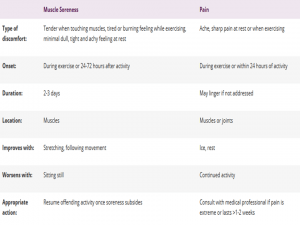As we discussed in our previous article , training by way of CrossFit has many benefits. With dedicated fitness training program, there will usually be some sort of accompanying physical discomfort secondary to your CrossFit training regime. The difficult part for newer, and sometimes experienced athletes, is understanding the difference between exercise induced Delayed Onset Muscle Soreness (DOMS), and pain.
Finding Your Individual Training Threshold
The soreness associated with an increase in physical activity is a normal response to the external stressors placed on the body. In fact, whenever you do any kind of physical activity, not just CrossFit, your body suffers some damage in the form of micro-tears. These micro-tears are then repaired, which is one of the factors leading to muscle soreness, but is necessary for growth. Pain, however, is an unhealthy and abnormal response, and can be indicative of injury.
My premise is not, of course, that you should not push past your individualized training threshold. It is, however, that in order to make physical improvements, your body must be pushed to an appropriate level, and in an appropriate manner, to facilitate gains. Every athlete’s body is different, and as a result, your training threshold will vary when compared to the next athlete’s. Your individualized level will depend on your age, baseline strength and flexibility, and your type and level of participation in fitness related endeavors prior to starting CrossFit. Even an athlete who has been doing another form of exercise will experience a shift in training threshold when first starting CrossFit. Finding a happy medium, and remaining at a sustained level outside your threshold, will result in muscle soreness. Excessively exceeding this threshold results in pain and injury.
Any training program should, when done appropriately, progressively increase your training threshold. By way of example, when a previously sedentary individual begins an exercise program consisting of running, their threshold may be 5 minutes of sustained running or cardiovascular activity. With the proper training, and several weeks of progressive increases in relative intensity, the athlete’s threshold may increase to 20-30 minutes. The key point is training. The safest and most effective way to maximize fitness gains and minimize the risk of injury, is to be realistic about your individual training threshold, and be able to differentiate between moderate muscle soreness and pain. At CrossFit Prelude, it matters not that you were a college athlete, or a video game athlete, everyone starts off slowly, and only progresses once they demonstrate that their training threshold warrants an increase in the stimulus.
Delayed Onset Muscle Soreness Is Normal
Whenever you exercise, barring any physical limitation or injuries at the time, you should always push yourself to the limits of your threshold. Approximately 24-72 hours after a good training session, your muscular soreness will typically peak. This soreness, varying in degree, is the result of the small damage to the muscle fibers. During this period, your muscles many be tender, sore, and feel tight. When you move your arms, this may be initially uncomfortable, but you should continue to move the relevant muscle group in order to decrease soreness. If the soreness is too uncomfortable, and the workout calls for the use of the same primary or closely related secondary muscle groups, you should ask your coach to give you some alternate exercises to perform during the workout. Rest gives your muscles an adequate opportunity to recover.
Pain Is Your Body Telling You To Stop
If you have exceeded your threshold to an unhealthy degree, you may experience pain during or after your training session. During your session, if you feel pain, stop. Pain may manifest itself in a variety of ways, but typically in CrossFit we see pain in the muscles or joints. Similar to athletes with varying athletic thresholds, pain tolerance is also varied. You are the best judge of whether or not you are in pain, and no coach or athlete should tell you to push through the pain to continue to workout. There is no such thing as “No Pain, No Gain.” To be clear, you always push through the limits of your perceived athletic potential, but you should not push through pain. If your pain does not resolve itself in 7-10 days, you should consult with a qualified medical professional, and rest until you can once again exercise pain free. This is not a knock on your athletic ability or your willingness to suck it up, but may be necessary for you to enjoy a lifetime of wellness.
At CrossFit Prelude, we want you to remain injury free to the maximum extent possible, and reach your targeted level of fitness. Look out next week for our article on proper nutritional supplementation to enhance recovery and growth.
CrossFit Prelude. “The Beginning of Something Better.” What Is Your Something?

